NRS-415 Nursing Leadership and Interprofessional Collaboration Course Assignments & Discussions Study Guide
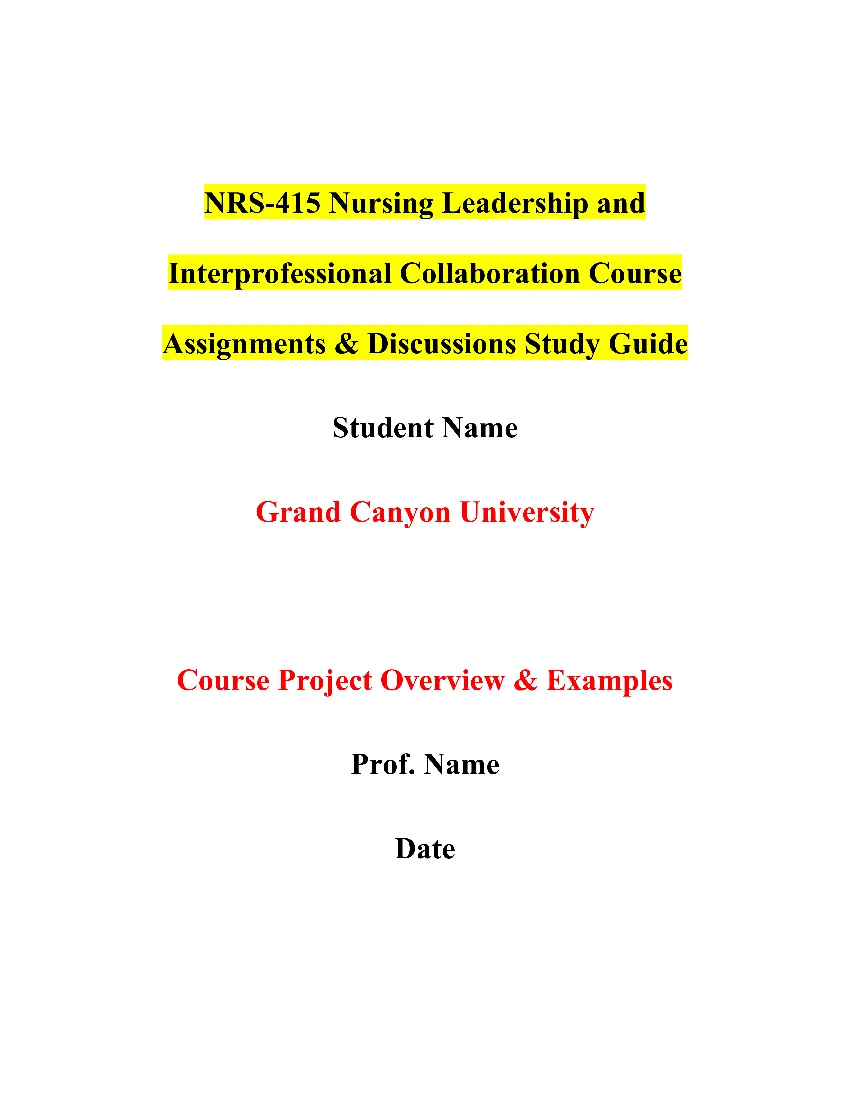 NRS-415 Nursing Leadership and Interprofessional Collaboration Course Description
NRS-415 Nursing Leadership and Interprofessional Collaboration Course Description
This course is an introduction to the Core Competencies for Professional Nursing Education, the role of the professional nurse, and the importance of effective nursing leadership. Standards of practice, differentiated nursing practice, professional accountability, interprofessional collaboration, and quality improvement are emphasized with importance placed on the application of leadership styles and management skills.
Class Resources
Dynamics in Nursing: Art and Science of Professional Practice
Grand Canyon University (Ed.). (2022). Dynamics in nursing: Art and science of professional practice (2nd ed.).
Nursing Leadership and Management: Leading and Serving
Grand Canyon University (Ed.). (2022). Nursing leadership and management: Leading and serving (3rd ed.).
Trends in Health Care: A Nursing Perspective
Grand Canyon University (Ed.). (2022). Trends in health care: A nursing perspective (2nd ed.).
Navigating Halo Learn
Use the “Navigating Halo Learn,” located in the GCU Technical Support Help Center, to get answers to frequently asked questions about navigating Halo, discussion forums, assignments, and quizzes Leadership and Interprofessional.
LopesWrite
Refer to the LopesWrite webpage for guidance regarding assignments requiring submission to LopesWrite. https://support.gcu.edu/hc/en-us/articles/201277380-LopesWrite
APA Writing Style
Utilize the APA paper template and the APA Style Guide, located in the Student Success Center, to ensure correct paper formatting when preparing applicable assignments.
GCU Library Citing Sources in APA Research Guide
Refer to the “Citing Sources in APA” Research Guide, located on the GCU Library website, for assistance with citing and referencing sources using APA formatting.
Introduction to the GCU Library Research Guide
Refer to the “Introduction to the GCU Library” Research Guide, located on the GCU Library website, to become familiar with the services and resources provided by the GCU Library.
GCU Library Academic Writing and Study Skills Guide
Utilize the GCU Library Academic Writing and Study Skills Guide. https://libguides.gcu.edu/writing
GCU Library Nursing and Health Sciences Research Guide
Refer to the “Nursing and Health Sciences” Research Guide, located on the GCU Library website, for library resources and information pertaining to nursing and health sciences.
Library Walkthrough Tutorial
View the “Library Walkthrough Tutorial,” located on the GCU Library website. Please be sure to click through each video and watch the entire series of videos.
GCU Library NRS-415 Nursing Leadership and Interprofessional Collaboration Guide
Utilize the GCU Library NRS-415 Nursing Leadership and Interprofessional Collaboration Guide, located on the Nursing and Health Sciences Guide page of the GCU Library website.
RN-BSN DQ Rubric
Refer to the “RN-BSN Discussion Question Rubric,” to understand the expectations for initial discussion question posts.
RN-BSN Participation Rubric
Refer to the “RN-BSN Participation Rubric,” to understand the expectations for participation.
You can also read another study guide on nursing assignments for students from another post on NRS-425 Health Promotion and Population Health Course Assignments & Discussions.
NRS-415 Nursing Leadership and Interprofessional Collaboration Topic 1: Essentials of Baccalaureate Education and Nursing History
Objectives:
- Discuss characteristics of successful students.
- Analyze the relationship between academic integrity and professional accountability in nursing practice.
- Describe how historical events and nursing leaders have influenced the practice of nursing.
Jan 29, 2024 – Feb 4, 2024 Max Points: 138
Resources
The Essentials: Core Competencies for Professional Nursing Education
Read “The Essentials: Core Competencies for Professional Nursing Leadership and Interprofessional Education,” by the American Association of Colleges of Nursing (AACN) (2021), located on the AACN website. This resource provides the educational framework, domains, concepts in nursing practice, and expectations for 4-year colleges and universities teaching nursing.
The Writing Process
View “The Writing Process,” located on the GCU website. This resource features an interactive guide about the college essay writing process.
Academic Integrity
Read the “About LopesWrite” and “Plagiarism” sections of the Academic Integrity page of the GCU website. This resource presents the five fundamental values that focus on academic integrity. Tutorials cover examples of policy violations, citing sources, and preventing plagiarism.
http://students.gcu.edu/academics/academic-integrity.php
Common Reference Examples Guide
Review the “Common Reference Examples Guide,” from APA Style (2022), located on the American Psychological Association (APA) website. This resource provides guidance and examples of common references in APA style.
Academic Integrity Tutorial
Complete the “Academic Integrity Tutorial,” as part of your Topic 1 assignment. This resource provides a detailed GCU Academic Integrity tutorial that helps students understand GCU’s Code of Conduct policy and ways to avoid committing plagiarism.
Essentials of Evidence Based Practice
Read “Essentials of Evidence Based Practice,” by Zimmerman, from the International Journal of Childbirth Education (2017). This article provides an overview of evidence-based practice (EBP) through the use of definitions and models. This article should be used to complete parts of Quiz 1.
https://lopes.idm.oclc.org/login?url=https://search.ebscohost.com/login.aspx? direct=true&db=cul&AN=123698143&site=ehost- live&scope=site&custid=s8333196&groupid=main&profile=ehost
Undergraduate Field Experience Manual
Refer to the Guidelines for Undergraduate Field Experiences (Undergraduate Field Experience Manual), located on the college page of the Student Success Center under the Practicum/Field Experience tab. This resource provides additional information regarding direct and indirect care experiences encountered in the RN-BSN program Leadership and Interprofessional.
God’s Survival Plan for Nursing Students
Read “God’s Survival Plan for Nursing Students,” by Moore and De Haan, from Journal of Christian Nursing Leadership and Interprofessional (2022). This resource provides tips and strategies for nursing students and finding God’s wisdom as part of the plan in their career.
https://lopes.idm.oclc.org/login?url=http://ovidsp.ovid.com.lopes.idm.oclc.org/ovidweb.cgi? T=JS&CSC=Y&NEWS=N&PAGE=fulltext&AN=00005217-202201000-00008&LSLINK=80&D=ovft
Reference Guide for Journal Articles, Books, and Edited Book Chapters
Review the “Reference Guide for Journal Articles, Books, and Edited Book Chapters,” from APA Style
(2020). This resource provides guidance and examples of common references for journal articles, books, and edited book chapters in APA style.
APA Citing and Formatting Webinar
Explore the “Webinars and Workshops: Webinar Calendar” page of the GCU Library to find the available days and times for taking the “APA Citing and Formatting Webinar Leadership and Interprofessional.” Sign up and take this webinar. This calendar also provides dates and times for other webinars and workshops offered by the GCU Library.
How to Cite Properly
Explore the “How to Cite Properly” page of the Student Success Center. This academic integrity resources on this page provide students with guidance on citing references properly to give credit to the original author(s) of a work.
Succeeding in an Online Nursing Program
Read “Succeeding in an Online Nursing Program,” by Sanders, from Nursing Leadership and Interprofessional Made Incredibly Easy (2019). This resource provides key tips for success in an online program, including preparing for a course, student-student and student-faculty relationships, organizing your time, and making the most of feedback.
T=JS&CSC=Y&NEWS=N&PAGE=fulltext&AN=00152258-201901000-00004&LSLINK=80&D=ovft
7 Habits of Highly Effective Nursing Students
Read “7 Habits of Highly Effective Nursing Students,” by Murphy (2015), located on the Minority Nurse blog website. This resource provides effective time management tools to help nursing students find balance with school, work, and life.
Assessments
Summary of Current Course Content Knowledge
Start Date & Time Due Date & Time Points Jan 29, 2024, 12:00 AM Jan 29, 2024, 11:59 PM 0
Assessment Description
Academic engagement through active participation in instructional activities related to the course objectives is paramount to your success in this course and future courses. Through interaction with your instructor and classmates, you will explore the course material and be provided with the best opportunity for objective and competency mastery. To begin this class, Leadership and Interprofessional review the course objectives for each Topic, and then answer the following questions as this will help guide your instructor for course instruction.
- Which weekly objectives do you have prior knowledge of and to what extent?
- Which weekly objectives do you have no prior knowledge of?
- What course-related topics would you like to discuss with your instructor and classmates? What questions or concerns do you have about this course?
Class Introductions
Start Date & Time Due Date & Time Points Jan 29, 2024, 12:00 AM Jan 31, 2024, 11:59 PM 0
Assessment Description
Take a moment to explore your new classroom and introduce yourself to your fellow classmates. What are you excited about learning? What do you think will be most challenging?
Topic 1 DQ 1
Jan 29, 2024, 12:00 AM Jan 31, 2024, 11:59 PM 8
Assessment Description
The Topic 1 Resource, “The Essentials: Core Competencies for Professional Nursing Leadership and Interprofessional Education,” represents the core competencies of professional nursing education and provides a framework that nursing programs use to prepare professional nurses. The RN-BSN program at Grand Canyon University meets the requirements for clinical competencies as defined by the Commission on Collegiate Nursing Education (CCNE) and the American Association of Colleges of Nursing (AACN), using both direct and indirect care experiences for practicing nurses. In your practicum course, you will complete these hours with a preceptor and work to develop a change project.
Which of the 10 domains in the “The Essentials: Core Competencies for Professional Nursing Leadership and Interprofessional Education” are you interested in learning more about and why? Based on the readings in the Class and Topic 1 Resources, what are some characteristics of successful students and what strategies can you implement to be a successful student? Identify a role model or mentor who would be able to support your professional growth.
Initial discussion question posts should be a minimum of 200 words and include at least two references cited using APA format. Responses to peers or faculty should be 100-150 words and include one reference Leadership and Interprofessional. Refer to “RN-BSN Discussion Question Rubric” and “RN-BSN Participation Rubric,” located in Class Resources, to understand the expectations for initial discussion question posts and participation posts, respectively.
American Association of Colleges of Nursing Core Competencies for Professional Nursing Education
This assignment aligns to AACN Core Competency 10.2.
Topic 1 DQ 2
Start Date & Time Due Date & Time Points Jan 29, 2024, 12:00 AM Feb 2, 2024, 11:59 PM 8
Assessment Description
How has nursing practice evolved over time? Explain the significance of evidence-based practice and critical thinking in modern nursing. Identify one key nursing leader and summarize one historical event that has shaped contemporary nursing practice, the advancement of nursing as a profession, and the development of nursing roles. Select a leader and a historical event different from those identified by your classmates Leadership and Interprofessional.
Initial discussion question posts should be a minimum of 200 words and include at least two references cited using APA format. Responses to peers or faculty should be 100-150 words and include one reference. Refer to “RN-BSN Discussion Question Rubric” and “RN-BSN Participation Rubric,” located in Class Resources, to understand the expectations for initial discussion question posts and participation posts, respectively Leadership and Interprofessional.
American Association of Colleges of Nursing Core Competencies for Professional Nursing Education
This assignment aligns to AACN Core Competencies 1.1, 9.5.
Academic Integrity Tutorial and Response
Jan 29, 2024, 12:00 AM Feb 4, 2024, 11:59 PM 30
Assessment Description
Review the “Academic Integrity” page and complete the “Academic Integrity Tutorial” quiz, both located in the Topic 1 Resources Leadership and Interprofessional. After you have completed the quiz, download your “Certificate of Completion” and include it as part of your assignment submission.
In less than 250 words, discuss how academic integrity in the classroom relates to professional accountability in nursing practice. How will you ensure academic integrity in your work?
Submit your “Certificate of Completion” and response document to the assignment dropbox.
While APA style is not required for the body of this assignment, solid academic writing is expected, and documentation of sources should be presented using APA formatting guidelines, which can be found in the APA Style Guide, located in the Student Success Center Leadership and Interprofessional.
You are not required to submit this assignment to LopesWrite.
American Association of Colleges of Nursing Core Competency for Professional Nursing Education
This assignment aligns to AACN Core Competency 10.1.
Library Resources and APA Quiz
Start Date & Time Due Date & Time Points Jan 29, 2024, 12:00 AM Feb 4, 2024, 11:59 PM 60
Assessment Description
Review the Topic 1 Resources related the GCU Library and APA formatting before completing the Library Resources and APA Quiz.
Topic 1 Participation
Start Date & Time Due Date & Time Points Jan 29, 2024, 12:00 AM Feb 4, 2024, 11:59 PM 32
NRS-415 Nursing Leadership and Interprofessional Collaboration Topic 2: Professional Accountability, Standards of Practice, Differentiated Practice, and Professional Development
Objectives:
- Compare and contrast the scope of practice of licensed practical nurses (LPNs), registered nurses (RNs), and
advanced practice registered nurses (APRNs).
- Define professional accountability in nursing practice.
- Evaluate personal conduct in the use of social media and its effects on professional accountability.
- Describe the role of the standards of practice in promoting professional development.
Feb 5, 2024 – Feb 11, 2024 Max Points: 158
Resources
Chapter 3: The Nursing Workforce
Read Chapter 3, “The Nursing Workforce,” by Wakefield, Le Menestrel, and Flaubert, from The Future of Nursing 2020-2030: Charting a Path to Achieve Health Equity (2021). This resource provides insights into the status of the current nursing workforce, including various practice levels and practice settings.
http://ebookcentral.proquest.com.lopes.idm.oclc.org/lib/gcu/reader.action?docID=6697061&ppg=92
Code of Ethics for Nurses With Interpretive Statements
Review the American Nurses Association (ANA)’s “Code of Ethics for Nurses With Interpretive Statements.” This resource provides information on the 9 provisions of the ANA code.
https://www.nursingworld.org/practice-policy/nursing-excellence/ethics/code-of-ethics-for-nurses/coe-view- only/
Trends in Health Care: A Nursing Perspective
Read Chapter 4 in Trends in Health Care: A Nursing Perspective. This chapter discusses advocacy, lobbying, and nurses’ roles at the federal government level. Proposing legislation is presented. A discussion on the Health Insurance Portability and Accountability Act (HIPAA) of 1996 is included.
Scope of Nursing Practice
Read “Scope of Nursing Practice,” by the American Nurses Association (ANA) (2015), in Nursing: Scope and Standards of Practice, located on the ANA website. This resource defines and outlines the scope and standards of nursing practice which are useful in addressing the first discussion question Leadership and Interprofessional.
How Nurses Should be Using Social Media
Read “How Nurses Should Be Using Social Media,” by EveryNurse Staff (2018), located on the EveryNurse blogsite. This article presents information regarding privacy issues, positive ways to use social media, and practices to avoid. Social media policies and consequences are discussed.
https://everynurse.org/how-nurses-should-be-using-social-media/ #:~:text=Blow%20Off%20Work%2DRelated%20Steam,social%20media%2C%E2%80%9D%20he%20says.
A Nurse’s Guide to the Use of Social Media
Read “A Nurse’s Leadership and Interprofessional Guide to the Use of Social Media,” by the National Council of State Boards of Nursing (NCSBN) (2018), located on the NCSBN website. This resource provides information regarding the appropriate use of social media in light of patient privacy and confidentiality laws. Various scenarios are presented.
Optional – Social Media
For additional information, the following is recommended:
Review the ANA’s Social Media webpage. This resource discusses the six principles created by ANA to help nurses protect themselves, patients, and the profession when using social media.
Using Social Media in Contemporary Nursing: Risks and Benefits
Read “Using Social Media in Contemporary Nursing: Risks and Benefits,” by Geraghty, Hari, and Oliver, from British Journal of Nursing (2021). This resource explores the advantages of using social media which include networking and data gathering while also exploring possible negative ethical and legal implications for nurses Leadership and Interprofessional.
https://lopes.idm.oclc.org/login?url=https://search.ebscohost.com/login.aspx? direct=true&db=cul&AN=153015105&site=ehost- live&scope=site&custid=s8333196&groupid=main&profile=ehost
Dynamics in Nursing: Art and Science of Professional Practice
Read Chapter 3 “Practice and Competency Development” of Dynamics in Nursing: Art and Science of Professional Practice. This chapter discusses the standards of professional nursing practice.
Assessments
Topic 2 DQ 1
Start Date & Time Due Date & Time Points Feb 5, 2024, 12:00 AM Feb 7, 2024, 11:59 PM 8
Assessment Description
The scope and standards of practice guide the nursing profession in competence and performance expectations. The scope of practice for nursing defines the activities that a person licensed as a nurse is permitted to perform while the standards of practice delineate performance expectations for all registered nurses. Review Chapter 3, “The Nursing Workforce,” of The Future of Nursing 2020-2030: Charting a Path to Achieve Health Equity, located in the Topic 2 Resources, and compare the scope of practice and differentiated practice competencies of licensed practical nurses (LPNs), Leadership and Interprofessional registered nurses (RNs), and advanced practice registered nurses (APRNs). Review “Scope of Nursing Practice” from Nursing: Scope and Standards of Practice, located in the Topic 2 Resources. Standard 12 of the standards of practice describes the nurse’s role related to education. Explain the role of professional development (life-long learning) in the context of this standard.
Initial discussion question posts should be a minimum of 200 words and include at least two references cited using APA format. Responses to peers or faculty should be 100-150 words and include one reference. Refer to “RN-BSN Discussion Question Rubric” and “RN-BSN Participation Rubric,” located in Class Resources, to understand the expectations for initial discussion question posts and participation posts, respectively Leadership and Interprofessional.
Topic 2 DQ 2
Start Date & Time Due Date & Time Points Feb 5, 2024, 12:00 AM Feb 9, 2024, 11:59 PM 8
Assessment Description
Read the scenario and address the discussion question:
Scenario
Nurse Leadership and Interprofessional Lope is starting a busy shift in which she was finishing report on Mr. Johnson. During report, Nurse Jim who was finishing his shift also gave Nurse Lope a medicine cup containing three of Mr. Johnson’s unopened medications that he reported were recently retrieved from the medication dispenser. Nurse Lope was told that these were supposed to have been given 30 minutes ago and asked if she could give them during bedside hand-off. As Nurse Lope planned to stay in Mr. Johnson’s room to complete his vital signs and assessment, she agreed with this plan.
When she opened Mr. Johnson’s electronic medical record to administer these medications, she noticed that these medications were scheduled to be given 3 hours ago. Additionally, one of the medications had a barcode that was not scanning to Mr. Johnson’s chart. Nurse Leadership and Interprofessional Lope proceeded to administer these medications so that she would not be late on the next round of medications, which included some of the same ones. It was later discovered that the medication that was not scanning was for another patient and should not have been given to Mr. Johnson.
Discussion Question
Outline the concept of professional accountability as it pertains to nursing. Examine the actions of Nurse Jim and Nurse Lope. Discuss how you would approach this scenario if you were in Jim’s and Lope’s position. Based on your analysis of how nurses demonstrate accountability in clinical practice, the nursing process, and evidence-based practice, explain how you would handle this situation if you were the nurse manager overseeing Jim and Lope Leadership and Interprofessional.
Initial discussion question posts should be a minimum of 200 words and include at least two references cited using APA format. Responses to peers or faculty should be 100-150 words and include one reference. Refer to “RN-BSN Discussion Question Rubric” and “RN-BSN Participation Rubric,” located in Class Resources, to understand the expectations for initial discussion question posts and participation posts, respectively Leadership and Interprofessional.
American Association of Colleges of Nursing Core Competencies for Professional Nursing Education
This assignment aligns to AACN Core Competencies 2.2, 2.5, 2.6, 9.4.
Professional Accountability Reflection
Start Date & Time Due Date & Time Points Feb 5, 2024, 12:00 AM Feb 11, 2024, 11:59 PM 110
Assessment Traits
Requires LopesWrite
Assessment Description
The purpose of this assignment is to evaluate personal and professional accountability in the context of social media. Social media plays a significant role in modern society and is now a common tool used by individuals and organizations alike to evaluate a person’s values, authenticity, and reputation. Additionally, social media is now considered a mainstream part of the process for recruiting and hiring candidates for employment Leadership and Interprofessional.
Inappropriate or unprofessional conduct on social media can pose legal problems for nurses as well as damage public trust in nursing.
For this assignment, log-in to each social media platform for which you have an account. Review your profile and most recent activity including pictures and posts. If you do not have a social media account, access one of the following social media platforms in order to view the social media posts and activities of others: Facebook, Instagram, Twitter, YouTube, TikTok. Reflect on the information and content you and others post on a daily basis Leadership and Interprofessional.
In 500-750 words, summarize your findings. Include the following in your summary:
- Describe the posts, conversations, and images you evaluated.
- Does the activity on social media appear to align with your personal values and the professional values of your discipline?
- Would family, friends, and colleagues consider the posts, conversations, and images authentic and representative of who you are as unique individuals?
- Does the activity on social media respect the human value and dignity of others as reflected in Christian values?
- Discuss why nurses have a responsibility to uphold a standard of conduct consistent with professional values, regulatory requirements, and workplace policies in both personal and professional interactions. Include a discussion of how personal conduct can violate the Health Insurance Portability and Accountability Act (HIPAA) of 1996 or be considered unethical and unprofessional. Provide an example to support your answer Leadership and Interprofessional.
Prepare this assignment according to the guidelines found in the APA Style Guide, located in the Student Success Center.
This assignment uses a rubric. Please review the rubric prior to beginning the assignment to become familiar with the expectations for successful completion.
You are required to submit this assignment to LopesWrite. A link to the LopesWrite technical support articles is located in Class Resources if you need assistance.
American Association of Colleges of Nursing Core Competencies for Professional Nursing Education
This assignment aligns to AACN Core Competencies 6.1, 8.1, 8.5, 9.1, 9.3, 9.4, 9.5, 10.2.
Topic 2 Participation
Start Date & Time Due Date & Time Points Feb 5, 2024, 12:00 AM Feb 11, 2024, 11:59 PM 32
NRS-415 Nursing Leadership and Interprofessional Collaboration Topic 3: Theories, Concepts, and Roles in Nursing Leadership and Management
Objectives:
- Analyze one’s personal leadership style.
- Discuss the significance of emotional intelligence for effective leadership and relationship dynamics.
- Discuss how the theory of servant leadership supports leadership competencies.
- Evaluate an issue for a legislative proposal.
Feb 12, 2024 – Feb 18, 2024 Max Points: 218
Resources
Dynamics in Nursing: Art and Science of Professional Practice
Read “Ethical Practice in Nursing” section of Chapter 1 in Dynamics in Nursing: Art and Science of Professional Practice. This chapter provides an overview of ethics in nursing practice.
Optional – Core Values
For additional information, the following is recommended:
By completing the activity, “Core Values,” located on the GCU website, you can reflect on your core values as a leader. This is an activity for students to complete to determine their personal model of leadership. The activity takes approximately 5 to 10 minutes to complete.
Emotional Intelligence in Nursing Leadership
Read “Emotional Intelligence in Nursing Leadership,” by Butler, from Australian Nursing and Midwifery Journal
(2021). The resource highlights the importance of emotional intelligence (EI) in nursing leadership.
https://lopes.idm.oclc.org/login?url=https://search.ebscohost.com/login.aspx?
direct=true&db=a9h&AN=152572611&site=ehost- live&scope=site&custid=s8333196&groupid=main&profile=ehost
The Power of Influence: Nurses’ Role in Advocacy and the Legislative Process
Read “The Power of Influence: Nurses’ Role in Advocacy and the Legislative Process,” by Varghese and Moss, from AAACN Viewpoint (2021). This resource discusses the importance of advocacy by nurses to influence legislation in support of issues important to nursing and health care.
https://lopes.idm.oclc.org/login?url=https://search.ebscohost.com/login.aspx? direct=true&db=cul&AN=152869671&site=ehost- live&scope=site&custid=s8333196&groupid=main&profile=ehost
How a Bill Becomes a Law
View “How a Bill Becomes a Law,” by GCU Academics – Nursing (2016), located on the GCU website. This video, which demonstrates how a bill becomes a law, will assist you in completing the topic assignment.
Influencing Health Care in the Legislative Arena
Read “Influencing Health Care in the Legislative Arena,” by Abood, from New Hampshire Nursing News
(2007). This resource discusses the need for nurses to be advocates in the world of policy and politics. This will help nurses to shape and influence health care and health care policies.
https://lopes.idm.oclc.org/login?url=https://search.ebscohost.com/login.aspx? direct=true&db=cul&AN=106289356&site=ehost- live&scope=site&custid=s8333196&groupid=main&profile=ehost
Optional – Trends in Health Care: A Nursing Perspective
For additional information, the following is recommended:
Chapter 5 of Trends in Health Care: A Nursing Perspective. This resource discusses real-life leadership experiences and leadership competencies.
Optional – Mindfulness: A Necessary Leadership and Interprofessional Competency
For additional information, the following is recommended:
“Mindfulness: A Necessary Leadership Competency,” by Parchment, from Nursing Made Incredibly Easy (2022). This resource reviews why mindfulness is important, its benefits, and why it matters in health care.
T=JS&CSC=Y&NEWS=N&PAGE=fulltext&AN=00152258-202203000-00005&LSLINK=80&D=ovft
Optional – The Relationship Between the Implicit Rationing of Nursing Care and Emotionally Intelligent Leadership Style
For additional information, the following is recommended:
“The Relationship Between the Implicit Rationing of Nursing Care and Emotionally Intelligent Leadership Style,” by Blizzard and Woods, from Journal of Nursing Administration (2020). This resource gives students a glimpse into how research is used to evaluate emotional intelligence in nursing leadership.
https://lopes.idm.oclc.org/login?url=http://ovidsp.ovid.com.lopes.idm.oclc.org/ovidweb.cgi? T=JS&CSC=Y&NEWS=N&PAGE=fulltext&AN=00005110-202012000-00004&LSLINK=80&D=ovft
Interdisciplinary Relationship Dynamics
Read “Interdisciplinary Relationship Dynamics,” by Peek and Campbell, from American Journal of Health-System Pharmacy (2020). This resource describes the importance of interdisciplinary collaboration and research/ recommendations to build these relationships.
https://lopes.idm.oclc.org/login?url=https://search.ebscohost.com/login.aspx? direct=true&db=a9h&AN=142126254&site=ehost- live&scope=site&custid=s8333196&groupid=main&profile=ehost
Nursing Leadership and Management: Leading and Serving
Read Chapters 1 and 2 of Nursing Leadership and Management: Leading and Serving. Chapter 1 discusses leadership theories and styles. Chapter 2 discusses the main tasks of a leader, conflict management, and accountability.
Assessments
Topic 3 DQ 1
Start Date & Time Due Date & Time Points Feb 12, 2024, 12:00 AM Feb 14, 2024, 11:59 PM 8
Assessment Description
Reflect on your personal and professional values and conscious or unconscious biases that influence your leadership style. What is one strength and one weakness of your leadership style? How does your leadership style impact your relationship dynamics and conflict management approach?
Initial discussion question posts should be a minimum of 200 words and include at least two references cited Leadership and Interprofessional
using APA format. Responses to peers or faculty should be 100-150 words and include one reference. Refer to “RN-BSN Discussion Question Rubric” and “RN-BSN Participation Rubric,” located in Class Resources, to understand the expectations for initial discussion question posts and participation posts, respectively.
American Association of Colleges of Nursing Core Competencies for Professional Nursing Education
This assignment aligns to AACN Core Competencies 9.6, 10.3.
Topic 3 DQ 2
Start Date & Time Due Date & Time Points Feb 12, 2024, 12:00 AM Feb 16, 2024, 11:59 PM 8
Assessment Description
One of the five elements of emotional intelligence is self-awareness. Explain what it means to be self-aware and describe why emotional intelligence is crucial for effective leadership. Discuss what behaviors someone with a high degree of self-awareness would demonstrate within the context of leading and managing groups. Provide an example Leadership and Interprofessional.
Initial discussion question posts should be a minimum of 200 words and include at least two references cited using APA format. Responses to peers or faculty should be 100-150 words and include one reference. Refer to “RN-BSN Discussion Question Rubric” and “RN-BSN Participation Rubric,” located in Class Resources, to understand the expectations for initial discussion question posts and participation posts, respectively Leadership and Interprofessional.
American Association of Colleges of Nursing Core Competencies for Professional Nursing Education
This assignment aligns to AACN Core Competencies 2.2, 9.3, 9.5.
Benchmark – Creating Change Through Advocacy
Start Date & Time Due Date & Time Points Feb 12, 2024, 12:00 AM Feb 18, 2024, 11:59 PM 150
Assessment Traits
Requires LopesWrite Benchmark
Assessment Description
The purpose of this assignment is to identify a problem or concern in your organization, local community, or state in which change can occur through advocacy and legislation.
Nurses often become motivated to change aspects within the larger health care system based on their real- world experience. As such, many nurses take on an advocacy role to influence a change in regulations, policies, and laws that govern the larger health care system Leadership and Interprofessional.
Identify a problem or concern in your organization, local community, or state. Examples of problems relevant to nursing include, but are not limited to, title “nurse” protection, sharps injury prevention, nursing shortage,
nurse well-being, valuation of nursing services, etc. Research the issue you selected and use the attached “Creating Change Through Advocacy” template to complete this assignment Leadership and Interprofessional.
You are required to cite a minimum of three sources to complete this assignment. Sources must be published within the last 5 years, appropriate for the assignment criteria, and relevant to nursing practice.
While APA style is not required for the body of this assignment, solid academic writing is expected, and documentation of sources should be presented using APA formatting guidelines, which can be found in the APA Style Guide, located in the Student Success Center Leadership and Interprofessional.
This assignment uses a rubric. Please review the rubric prior to beginning the assignment to become familiar with the expectations for successful completion.
You are required to submit this assignment to LopesWrite. A link to the LopesWrite technical support articles is located in Class Resources if you need assistance.
Benchmark Information
This benchmark assignment assesses the following programmatic competencies and professional standards: RN-BSN
9.4: Comply with relevant laws, policies, and regulations.
American Association of Colleges of Nursing Core Competencies for Professional Nursing Education
This assignment aligns to AACN Core Competencies 3.2, 3.4, 3.5, 4.3, 9.4.
CLC – CLC Agreement Document for Topic 4 Assignment
Start Date & Time Due Date & Time Points Feb 12, 2024, 12:00 AM Feb 18, 2024, 11:59 PM 20
Assessment Traits Group
Assessment Description
This is a Collaborative Learning Community (CLC) assignment.
Download and complete the attached “Collaborative Learning Community (CLC) Agreement” form. Fill out the agreement and upload the completed document to the assignment dropbox. This agreement pertains to the CLC – Health Care Organization Evaluation assignment, due in Topic 4 Leadership and Interprofessional.
This agreement is to be completed in a group, which will be determined and assigned by your instructor. This agreement will be submitted and graded as a group assignment.
American Association of Colleges of Nursing Core Competencies for Professional Nursing Education
This assignment aligns to AACN Core Competencies 2.9.
Topic 3 Participation
Start Date & Time Due Date & Time Points Feb 12, 2024, 12:00 AM Feb 18, 2024, 11:59 PM 32
NRS-415 Nursing Leadership and Interprofessional Collaboration Topic 4: Interprofessional Collaboration and Organizational Culture and Values
Objectives:
- Define organizational culture and values.
- Examine how interprofessional collaboration and shared governance influence organizational culture and values.
- Apply knowledge of systems and interprofessional collaboration to work effectively across the continuum of care.
- Identify a change management model or theory to help support an organizational goal.
Feb 19, 2024 – Feb 25, 2024 Max Points: 238
Resources
Nursing Leadership and Management: Leading and Serving Read Chapter 4 in Nursing Leadership and Management: Leading and Serving. Optional: Review the “Strategic Planning” section of Chapter 2.
Interprofessional Collaboration During COVID-19
Read “Interprofessional Collaboration During COVID-19,” by Campoe, from MEDSURG Nursing (2020). This resource provides a high-level overview of the importance of interprofessional collaboration during the pandemic and the central role of the nurse.
https://lopes.idm.oclc.org/login?url=http://ovidsp.ovid.com.lopes.idm.oclc.org/ovidweb.cgi? T=JS&CSC=Y&NEWS=N&PAGE=fulltext&AN=00008484-202009000-00002&LSLINK=80&D=ovft
What Is Patient Safety Culture?
Read “What Is Patient Safety Culture?” by the Agency for Healthcare Research and Quality (AHRQ) (2022), located on the AHRQ website. This resource discusses patient safety culture and its relationship to clinical outcomes.
A Shared Governance Approach to Nursing Documentation Redesign Using Kotter’s Change Management Model
Read “A Shared Governance Approach to Nursing Documentation Redesign Using Kotter’s Change Management Model,” by Lindsay, from Nursing Management (2023). This resource provides an example of how health systems and national organizations collaborated during the pandemic to determine minimum nursing documentation requirements while applying Kotter’s change management theory Leadership and Interprofessional.
https://lopes.idm.oclc.org/login?url=http://ovidsp.ovid.com.lopes.idm.oclc.org/ovidweb.cgi? T=JS&CSC=Y&NEWS=N&PAGE=fulltext&AN=00006247-202303000-00004&LSLINK=80&D=ovft
Interprofessional Collaborative Practice Organizations
Locate the section heading, Interprofessional Collaborative Practice Organizations, in “Chapter 3: Interprofessional Collaboration” of Transitions to Professional Nursing Practice, by Murphy (2020), located on the Lumen Learning website, and read to the end of the section. This resource provides insights into interprofessional collaborative practice, core interprofessional behaviors, and barriers and promoters to collaboration.
Dynamics in Nursing: Art and Science of Professional Practice
Read the “Ethical Practice in Nursing” section of Chapter 4 from Dynamics in Nursing: Art and Science of Professional Practice. This provides an overview of ethics in nursing practice and is useful for participation in the discussion forum this week.
Optional – American Nurses Association Code of Ethics
For additional information, the following is recommended:
American Nurses Association (ANA) “Code of Ethics for Nurses With Interpretive Statements,” by the ANA (2015), located on the ANA website. The resource provides a link to the full ANA Code of Ethics, which is summarized in your textbook readings for this week.
Assessments
Topic 4 DQ 1
Start Date & Time Due Date & Time Points
Feb 19, 2024, 12:00 AM Feb 21, 2024, 11:59 PM 8
Assessment Description
Explain what factors lead to conflict in professional practice. Describe how organizational values and culture can influence the way conflict is addressed. Discuss effective strategies for resolving workplace conflict and preventing violence.
Initial discussion question posts should be a minimum of 200 words and include at least two references cited using APA format. Responses to peers or faculty should be 100-150 words and include one reference. Refer to “RN-BSN Discussion Question Rubric” and “RN-BSN Participation Rubric,” located in Class Resources, to understand the expectations for initial discussion question posts and participation posts, respectively Leadership and Interprofessional.
American Association of Colleges of Nursing Core Competencies for Professional Nursing Education
This assignment aligns to AACN Core Competencies 5.3, 6.2, 6.3, 6.4.
Topic 4 DQ 2
Start Date & Time Due Date & Time Points Feb 19, 2024, 12:00 AM Feb 23, 2024, 11:59 PM 8
Assessment Description
Read the scenario and address the discussion question:
Scenario
You are a member of an interdisciplinary team participating in patient rounds at the start of your shift. You notice the physician charting that the patient is alert and oriented x3, but the patient was clearly confused, which the physician acknowledged during rounds.
Discussion Question
How would you approach this scenario? Apply one of the ethical principles discussed in Dynamics of Nursing: Art and Science of Professional Practice to this scenario. Discuss how organizational culture can help manage errors.
Initial discussion question posts should be a minimum of 200 words and include at least two references cited using APA format. Responses to peers or faculty should be 100-150 words and include one reference. Refer to “RN-BSN Discussion Question Rubric” and “RN-BSN Participation Rubric,” located in Class Resources, to understand the expectations for initial discussion question posts and participation posts, respectively Leadership and Interprofessional.
American Association of Colleges of Nursing Core Competencies for Professional Nursing Education
This assignment aligns to AACN Core Competencies 5.2, 6.2, 6.4, 9.1, 9.2, 9.3.
CLC – Health Care Organization Evaluation
Start Date & Time Due Date & Time Points Feb 19, 2024, 12:00 AM Feb 25, 2024, 11:59 PM 160
Assessment Traits Group
Requires LopesWrite
Assessment Description
This is a Collaborative Learning Community (CLC) assignment.
This assignment is to be completed in a group, which will be assigned by your instructor. The presentation will be submitted and graded as a group assignment.
The purpose of this assignment is to evaluate a strategic plan as a means to assess readiness for change within a health care organization or network.
Research a health care organization or network within the United States (e.g., United Healthcare, Vanguard, Banner Health, Kaiser Permanente, Cleveland Clinic, etc.). Assess the readiness of the health care organization or network you have chosen to meet the health care needs of citizens in the next decade Leadership and Interprofessional.
Prepare a 12-15-slide PowerPoint that summarizes your assessment of the organization and proposes a strategic plan to ensure readiness. Include the following:
- Identify the health care organization or network. Discuss the organization’s mission, vision, and values. Describe the types of services that this organization provides and the geographic areas it serves.
- Describe the organization’s overall readiness to improve care outcomes based on your findings.
- Analyze your selected organization’s strategic plan to determine to what extent it addresses issues pertaining to network growth, nurse staffing, resource management, and patient satisfaction Leadership and Interprofessional.
- Examine how interprofessional collaboration and shared governance influence organizational culture and values.
- Identify a change management theory or model that could be used to support implementation of the strategic plan for this organization. Explain why this theory or model would be the best Leadership and Interprofessional.
You are required to cite a minimum of three sources to complete this assignment. Sources must be appropriate for the assignment and relevant to nursing practice.
Refer to the resource, “Creating Effective PowerPoint Presentations,” located in the Student Success Center, for additional guidance on completing this assignment in the appropriate style
Refer to the resource, “Creating Effective PowerPoint Presentations,” located in the Student Success Center, for additional guidance on completing this assignment in the appropriate style Leadership and Interprofessional.
While APA style is not required for the body of this assignment, solid academic writing is expected, and documentation of sources should be presented using APA formatting guidelines, which can be found in the APA Style Guide, located in the Student Success Center.
This assignment uses a rubric. Please review the rubric prior to beginning the assignment to become familiar with the expectations for successful completion.
You are required to submit this assignment to LopesWrite. A link to the LopesWrite technical support articles is located in Class Resources if you need assistance Leadership and Interprofessional.
American Association of Colleges of Nursing Core Competencies for Professional Nursing Education
This assignment aligns to AACN Core Competencies 2.2, 7.1, 7.2, 7.3.
Personal Reflection
Start Date & Time Due Date & Time Points Feb 19, 2024, 12:00 AM Feb 25, 2024, 11:59 PM 30
Assessment Traits
Requires LopesWrite
Assessment Description
The purpose of this assignment is to reflect on your collaborative practice within the CLC Health Organization Evaluation assignment Leadership and Interprofessional.
In 250-500 words, answer the following:
- Describe the communication tools and techniques used by your team. What were the strengths and weaknesses of the group when collaborating to complete this project?
- What strategy, or approach, would improve your collaborative practice in future projects?
- When working in a health care setting, how would interprofessional collaboration work to support quality and the improvement of patient outcomes?
While APA style is not required for the body of this assignment, solid academic writing is expected, and documentation of sources should be presented using APA formatting guidelines, which can be found in the APA Style Guide, located in the Student Success Center Leadership and Interprofessional.
This assignment uses a rubric. Please review the rubric prior to beginning the assigning to become familiar with the expectations for successful completion.
You are not required to submit this assignment to LopesWrite.
American Association of Colleges of Nursing Core Competencies for Professional Nursing Education
This assignment aligns to AACN Core Competencies 6.1, 6.2.
Topic 4 Participation
Start Date & Time Due Date & Time Points Feb 19, 2024, 12:00 AM Feb 25, 2024, 11:59 PM 32
NRS-415 Nursing Leadership and Interprofessional Collaboration Topic 5: Reengineering Health Care Through Advocacy and Activism
Objectives:
- Explain the value of professional advocacy and activism and how the concepts are applied by professional nursing organizations.
- Discuss the nurse’s role as an advocate within the interdisciplinary team in promoting patient quality and Leadership and Interprofessional
safety while addressing issues in practice.
- Apply leadership theories in addressing a practice issue.
- Discuss a quality improvement method that could be used in the delivery of patient care.
Feb 26, 2024 – Mar 3, 2024 Max Points: 248
Resources
Section 4: Ways to Approach the Quality Improvement Process (Page 2 of 2)
Read “Section 4: Ways to Approach the Quality Improvement Process (Page 2 of 2),” by the Agency for Healthcare Research and Quality (AHRQ) (2020), located on the AHRQ website. This resource describes commonly used quality improvement models and tools Leadership and Interprofessional.
https://www.ahrq.gov/cahps/quality-improvement/improvement-guide/4-approach-qi-process/ sect4part2.html
Quality Improvement Tools for Nursing Practice
Read “Quality Improvement Tools for Nursing Practice,” by Harkness and Pullen, from Nursing Made Incredibly Easy (2019). This article discusses quality improvement models.
https://lopes.idm.oclc.org/login?url=http://ovidsp.ovid.com.lopes.idm.oclc.org/ovidweb.cgi? T=JS&CSC=Y&NEWS=N&PAGE=fulltext&AN=00152258-201905000-00009&LSLINK=80&D=ovft
List of Nursing Organizations
Explore the “List of Nursing Organizations,” located on the Nurse.org website. This website provides a listing of many professional nursing organizations and other organizations related to the nursing profession
Nursing Leadership and Management: Leading and Serving
Read Chapter 5 in Nursing Leadership and Management: Leading and Serving. This chapter discusses organizational culture and the role of the nurse leader.
Assessments
Topic 5 DQ 1
Start Date & Time Due Date & Time Points Feb 26, 2024, 12:00 AM Feb 28, 2024, 11:59 PM 8
Assessment Description
Continuous quality improvement (CQI) is the responsibility of all nurses and is vital when addressing the challenges of the health care industry. Provide an example of how you would apply CQI in your current or past position. If you are new to health care, select a nurse practice issue and discuss how you would apply CQI to address the issue. Discuss a quality improvement method that could be used to support CQI in your example Leadership and Interprofessional.
Initial discussion question posts should be a minimum of 200 words and include at least two references cited using APA format. Responses to peers or faculty should be 100-150 words and include one reference. Refer to “RN-BSN Discussion Question Rubric” and “RN-BSN Participation Rubric,” located in Class Resources, to understand the expectations for initial discussion question posts and participation posts, respectively Leadership and Interprofessional.
American Association of Colleges of Nursing Core Competencies for Professional Nursing Education
This assignment aligns to AACN Core Competency 5.1.
Topic 5 DQ 2
Start Date & Time Due Date & Time Points Feb 26, 2024, 12:00 AM Mar 1, 2024, 11:59 PM 8
Assessment Description
Discuss how professional nursing organizations support the field of nursing and how they advocate for nursing practice. Explain the value professional nursing organizations have in advocacy and activism related to patient care. Choose a professional nursing organization that relates to your specialty area of interest. Discuss how this organization keeps its members informed of health care changes and opportunities the organization provides for continuing education and professional development Leadership and Interprofessional.
Initial discussion question posts should be a minimum of 200 words and include at least two references cited using APA format. Responses to peers or faculty should be 100-150 words and include one reference. Refer to “RN-BSN Discussion Question Rubric” and “RN-BSN Participation Rubric,” located in Class Resources, to understand the expectations for initial discussion question posts and participation posts, respectively Leadership and Interprofessional.
American Association of Colleges of Nursing Core Competencies for Professional Nursing Education
This assignment aligns to AACN Core Competency 9.3.
Benchmark – Applying Leadership and Management Principles
Start Date & Time Due Date & Time Points Feb 26, 2024, 12:00 AM Mar 3, 2024, 11:59 PM 200
Assessment Traits
Requires LopesWrite Benchmark
Assessment Description
The purpose of this assignment is to analyze the various approaches nursing leaders employ when addressing issues in practice.
Select an issue from the following list: workplace violence, workplace injury, unit restructuring, floating, nurse turnover, nurse staffing ratios, or use of contract employees (i.e., registry and travel nurses) Leadership and Interprofessional.
In a 1,000-1,250-word paper, discuss the following:
- Describe the issue you selected. Provide data to support how this issue impacts the quality of care in the setting in which it occurs.
- Using research evidence for support, present one possible solution that could be implemented to address the issue. In your discussion, be sure to include financial considerations as they relate to implementation of the solution.
- Describe a leadership style that would best address the issue.
- Discuss how this leadership style compares to your personal leadership style Leadership and Interprofessional.
- Compare two different leadership theories that could be applied to resolution of the issue. Explain how each theory would be effective in addressing the issue.
- Discuss the nurse’s role within an interdisciplinary team in promoting patient quality and safety while fostering professionalism to address this issue.
You are required to cite a minimum of three sources to complete this assignment. Sources must be appropriate for the assignment and relevant to nursing practice.
Prepare this assignment according to the guidelines found in the APA Style Guide, located in the Student Success Center.
This assignment uses a rubric. Please review the rubric prior to beginning the assignment to become familiar with the expectations for successful completion Leadership and Interprofessional.
You are required to submit this assignment to LopesWrite. A link to the LopesWrite technical support articles is located in Class Resources if you need assistance.
Benchmark Information
This benchmark assignment assesses the following programmatic competencies: RN-BSN
10.3: Develop capacity for leadership.
American Association of Colleges of Nursing Core Competencies for Professional Nursing Education
This assignment aligns to AACN Core Competencies 1.1, 2.5, 2.9, 3.2, 4.1, 4.2, 5.1, 5.2, 5.3, 7.2, 10.3.
Topic 5 Participation
Start Date & Time Due Date & Time Points Feb 26, 2024, 12:00 AM Mar 3, 2024, 11:59 PM 32
Make Your Nursing Academic Journey Truly Fulfilling with Our Expert Nursing Assignment Writing Help!
Feeling overwhelmed by the demands of your nursing essays and assignments? Don’t let stress derail your academic success. nursingcustomwriting.com is your partner in navigating the challenges of nursing studies. Our reliable nursing paper writing services are tailored to lighten your assignment load and ensure your journey in nursing education is not just manageable, but truly fulfilling.
Expertise That Sets Us Apart
At nursingcustomwriting.com, we understand the unique struggles faced by nursing students. That’s why we’ve assembled a team of seasoned nursing writers who are not only experts in their field but also passionate about helping students succeed. Our writers bring years of academic writing experience and a deep understanding of nursing topics, ensuring that your papers are meticulously crafted to meet the highest standards.
Why Choose nursingcustomwriting.com for Your Nursing Essays?
- Experienced Nursing Writers: Our team comprises experienced nursing professionals who are dedicated to delivering top-quality nursing papers tailored to your requirements.
- Direct Communication: You’ll have direct communication with your assigned writer, allowing for seamless collaboration and transparency throughout the writing process.
- Affordable Prices: We understand the financial constraints of students, which is why we offer competitive prices starting at just $10 per page.
- Guaranteed Originality: Plagiarism is a strict no-no at nursingcustomwriting.com. We guarantee 100% original, custom-made papers that reflect your unique voice and understanding.
- Timely Support: With our fast turnaround times and dedicated support team, you can rest assured that your papers will be delivered on time, every time.
- Hassle-Free Ordering: Ordering a custom nursing paper from nursingcustomwriting.com is quick and easy. Simply provide your details, and our experts will take care of the rest.
Why Struggle When Help Is Just a Click Away?
Don’t let nursing assignments overwhelm you. With nursingcustomwriting.com’s nursing writing help services, you can reclaim your time, achieve top grades, and stay ahead of the curve. Order your custom nursing paper today and unlock your full potential with nursingcustomwriting.com!
Don’t Let Stress Define Your Nursing Academic Journey
Place your order with nursingcustomwriting.com today and experience the difference firsthand. Whether you need to buy nursing research papers, get cheap nursing papers, or get professional nursing coursework help, we’ve got you covered. Trust us with your nursing assignments, and let us help you succeed in your nursing studies.


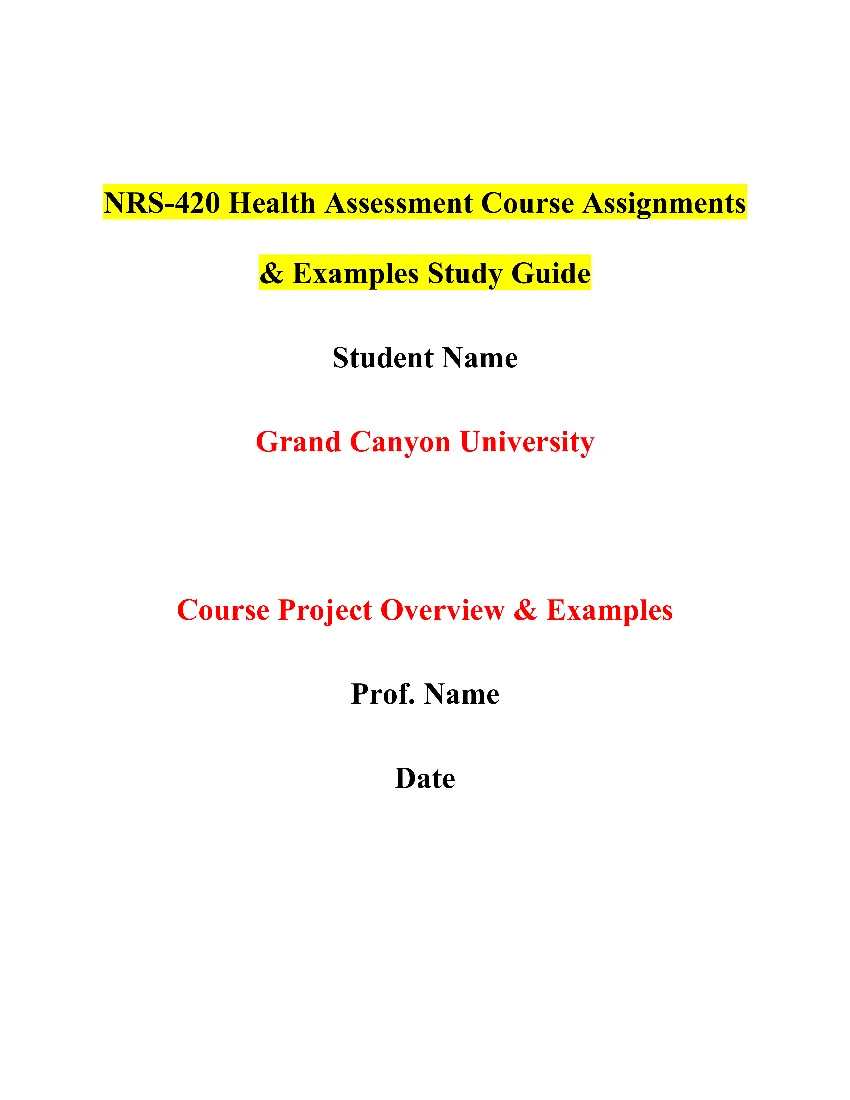 NRS-420 Health Assessment Course Description
NRS-420 Health Assessment Course Description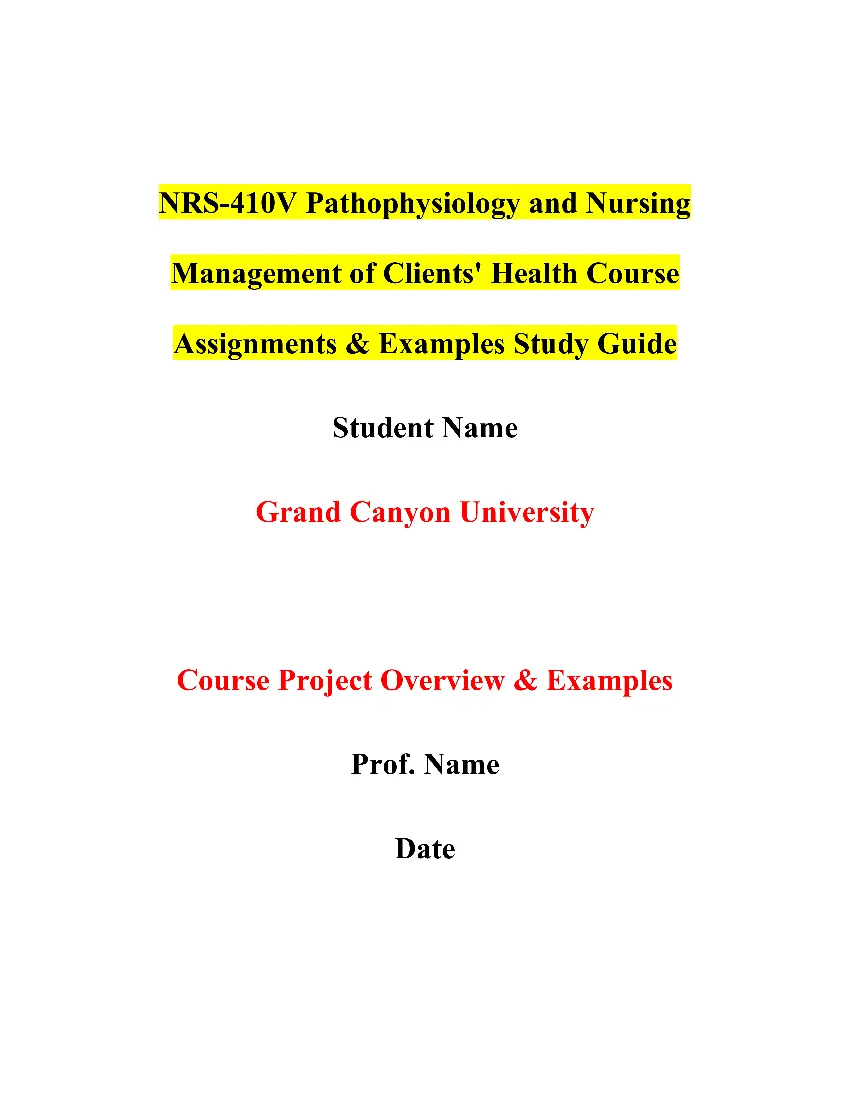 NRS-410V Pathophysiology and Nursing Management of Clients’ Health Course Description
NRS-410V Pathophysiology and Nursing Management of Clients’ Health Course Description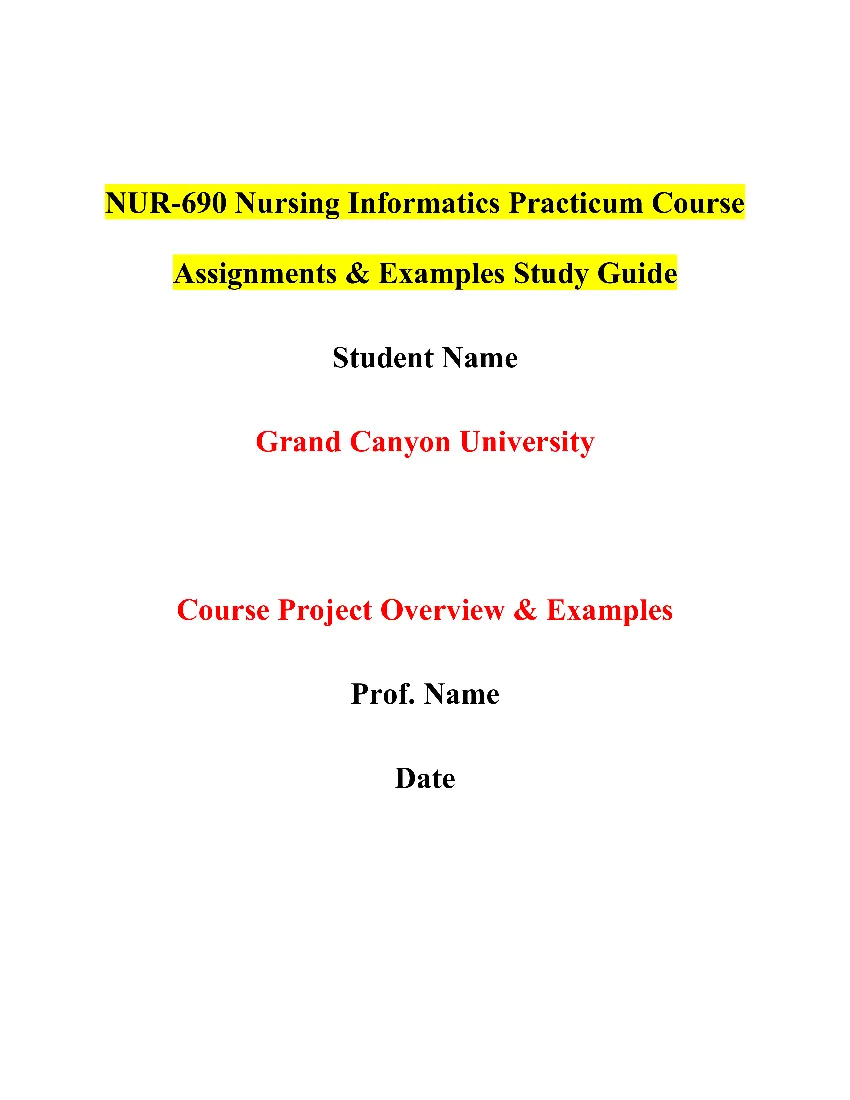 NUR-690 Nursing Informatics Practicum Course Description
NUR-690 Nursing Informatics Practicum Course Description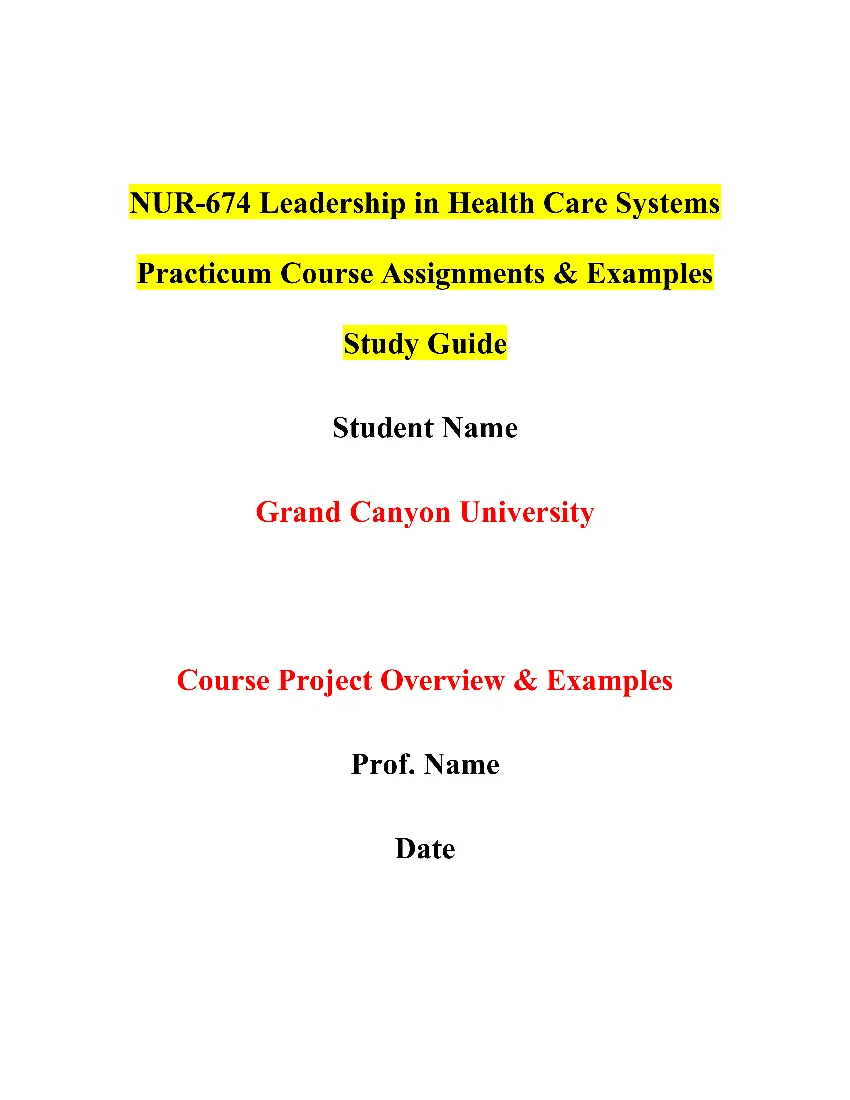 NUR-674 Leadership in Health Care Systems Practicum Course Description
NUR-674 Leadership in Health Care Systems Practicum Course Description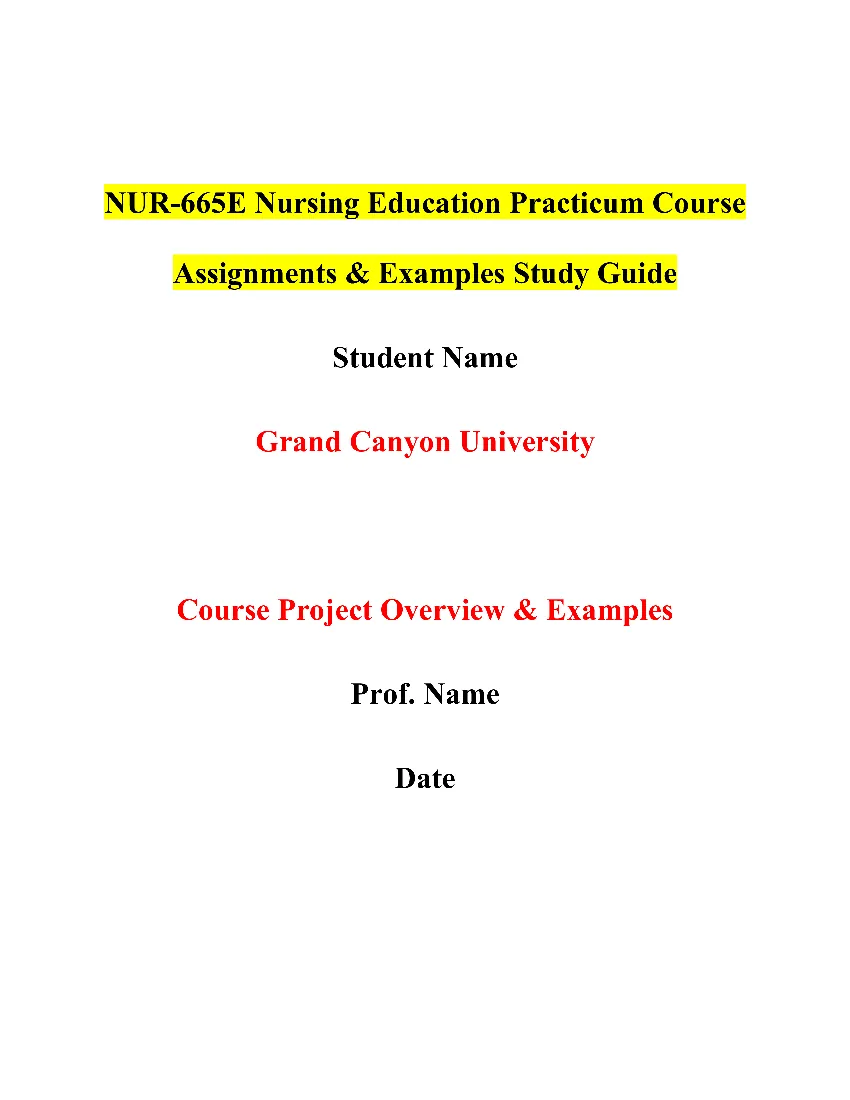 NUR-665E Nursing Education Practicum Course Description
NUR-665E Nursing Education Practicum Course Description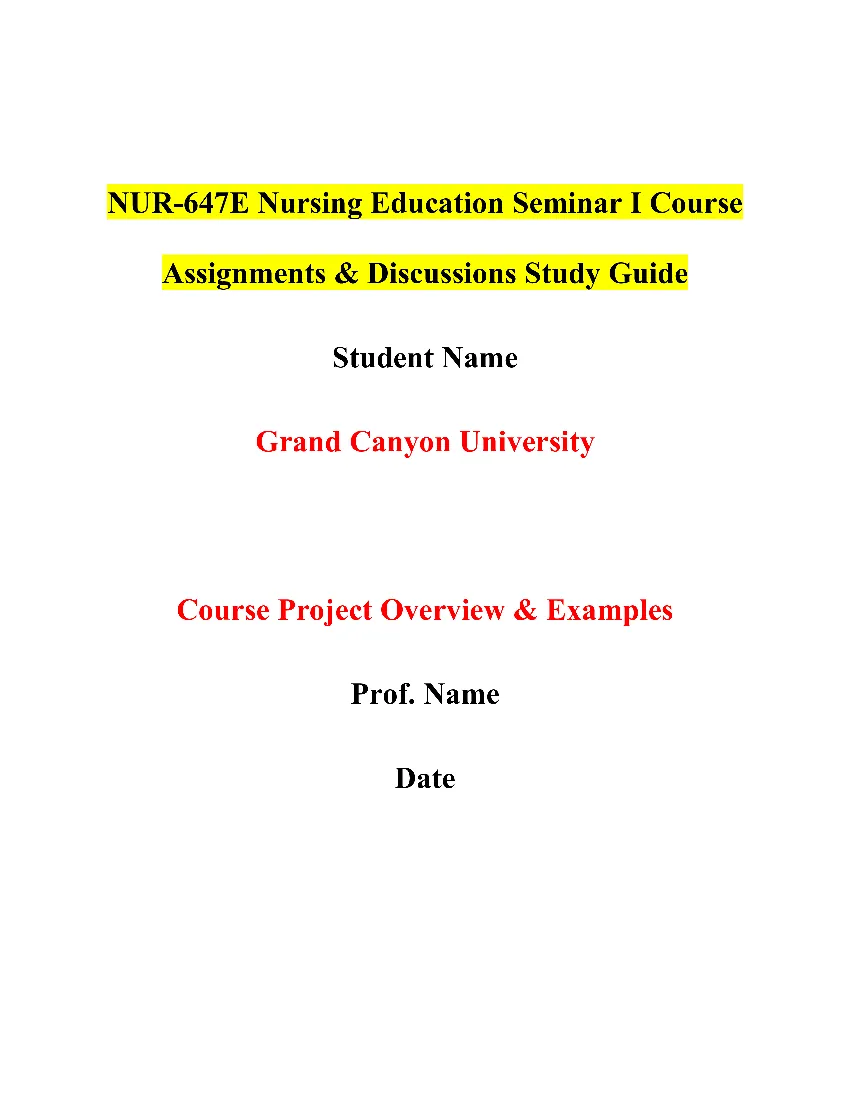 NUR-647E Nursing Education Seminar I Course Description
NUR-647E Nursing Education Seminar I Course Description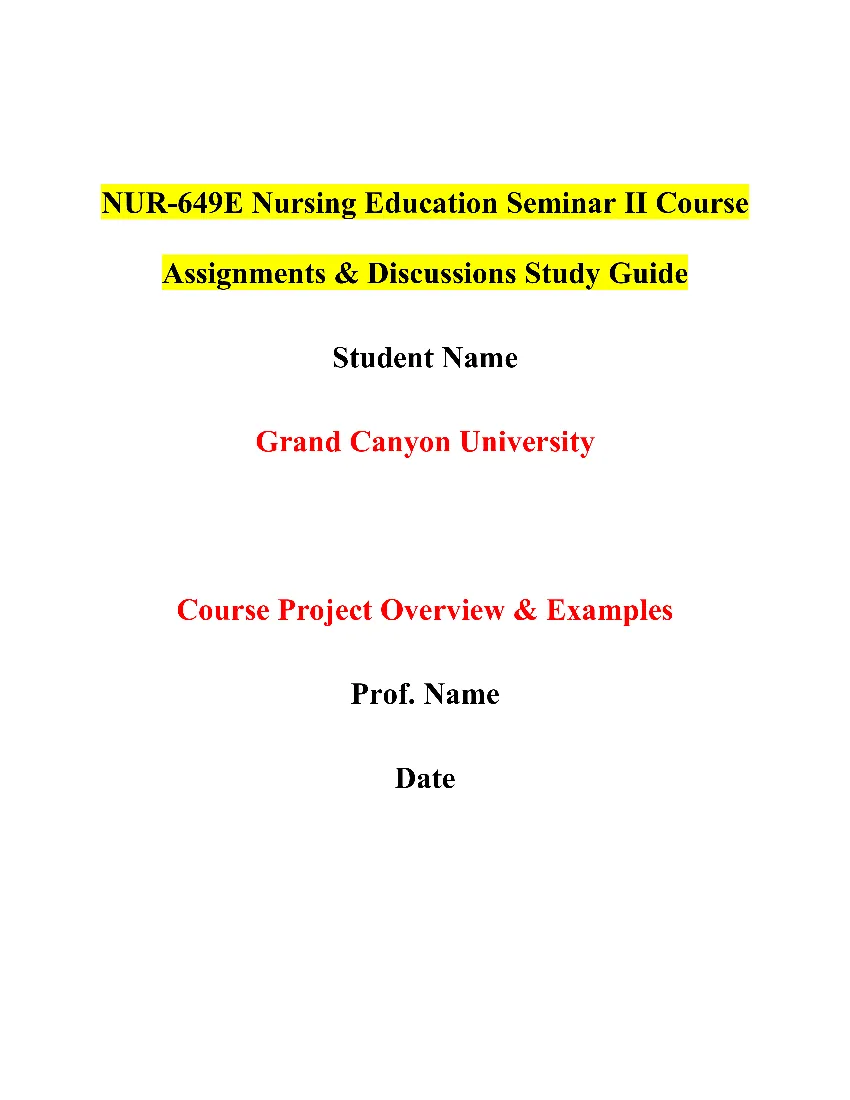 NUR-648E Nursing Education Seminar II Course Description
NUR-648E Nursing Education Seminar II Course Description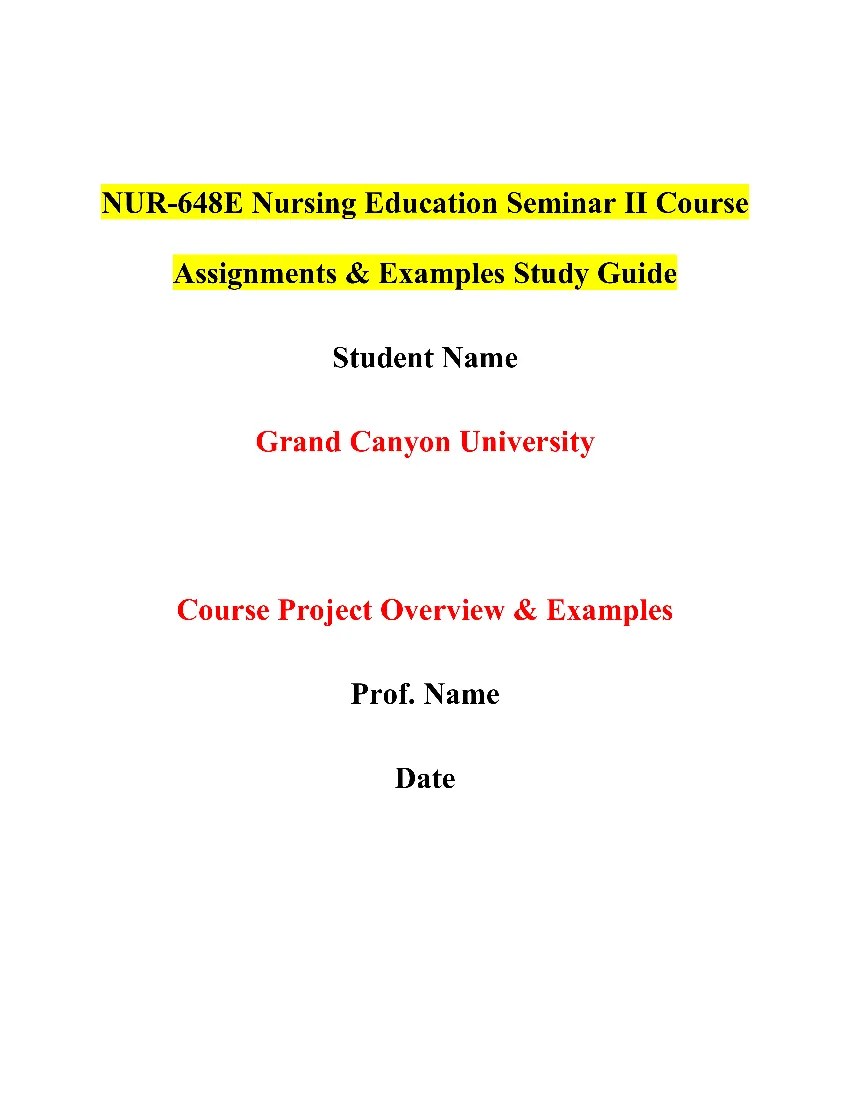 NUR-648E Nursing Education Seminar II Course Description
NUR-648E Nursing Education Seminar II Course Description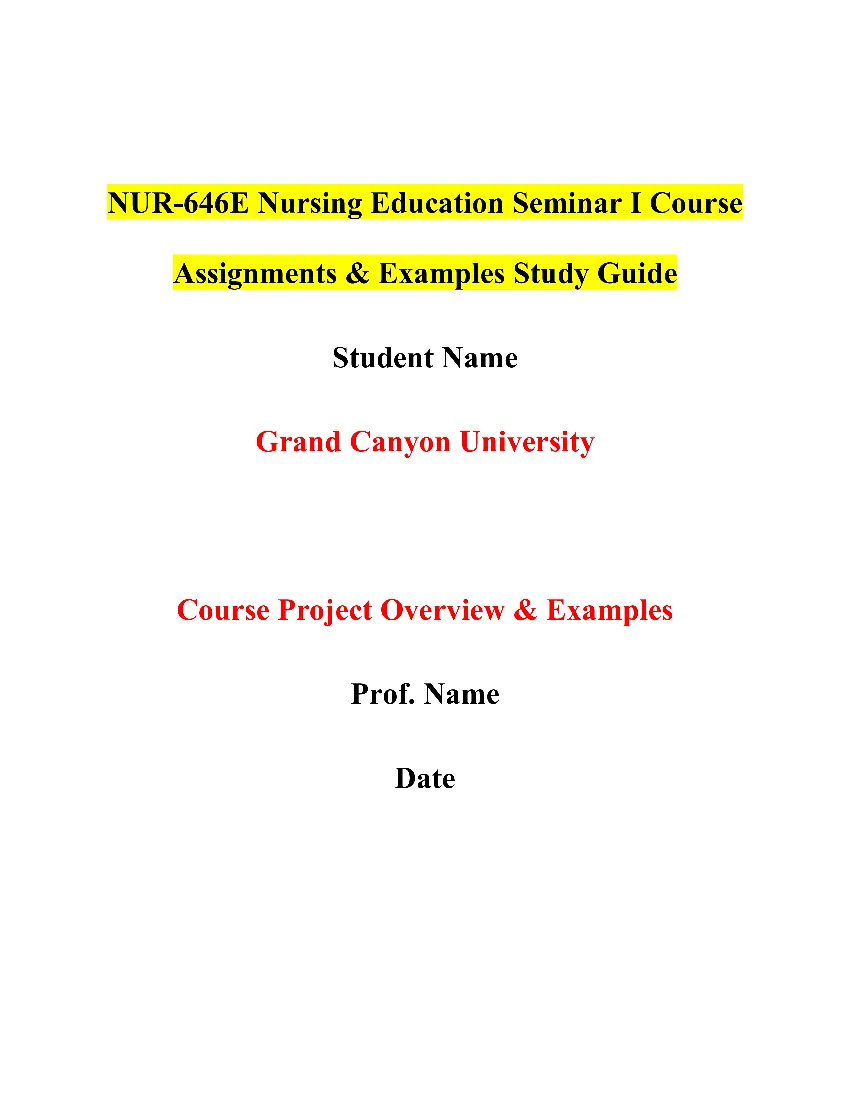 NUR-646E Nursing Education Seminar I Course Description
NUR-646E Nursing Education Seminar I Course Description